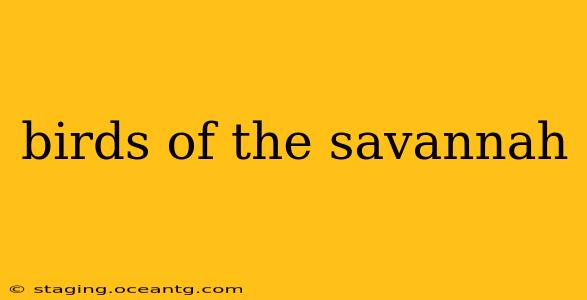The African savanna, a vast expanse of grasslands dotted with acacia trees and interspersed with woodlands, supports a remarkably diverse array of birdlife. From the majestic secretarybird to the tiny sunbirds, these avian inhabitants have adapted brilliantly to the unique challenges and opportunities of this iconic ecosystem. This article will explore the fascinating world of savanna birds, delving into their adaptations, behaviors, and the crucial role they play in the delicate balance of this ecosystem.
What are the main birds found in the Savannah?
The savanna boasts an incredible diversity of bird species, varying regionally. Some of the most commonly encountered include:
- Birds of Prey: Secretarybirds, martial eagles, bateleurs, and various species of hawks and falcons are apex predators, controlling rodent and reptile populations. Their keen eyesight and powerful talons are perfectly adapted for hunting in the open grasslands.
- Ground-dwelling Birds: Ostrich (the largest bird in the world!), guineafowl, various bustards, and coursers are well-suited to life on the ground. Their camouflage and running abilities help them evade predators.
- Tree-dwelling Birds: Hornbills, woodpeckers, weavers, and barbets utilize the scattered trees and shrubs for nesting, roosting, and foraging. Many are brightly colored and possess specialized beaks for accessing specific food sources.
- Waterfowl: Where water sources are available, you’ll find ducks, geese, herons, and egrets. These birds often congregate near rivers, lakes, or temporary waterholes.
- Smaller Birds: Sunbirds, bee-eaters, rollers, and numerous other smaller species contribute to the vibrant tapestry of savanna birdlife. Their diverse diets and specialized behaviors occupy various ecological niches.
What are some adaptations of Savannah birds?
Savanna birds display a remarkable range of adaptations shaped by the unique pressures of their environment:
- Camouflage: Many ground-dwelling birds exhibit cryptic plumage, blending seamlessly with the grasses and dry earth to avoid detection by predators.
- Flight: While some birds are strong fliers, others are adapted for running or hopping, enhancing their ability to escape from danger.
- Foraging Strategies: Different species have evolved distinct foraging behaviors, some specializing in catching insects, others in seed-eating, and still others as skilled hunters.
- Water Conservation: Many savanna birds possess efficient mechanisms for conserving water, especially crucial during the dry season.
- Nesting Strategies: Nest building strategies are highly varied, from elaborate woven nests in trees to simple scrapes on the ground.
What are the threats to Savannah birds?
Several threats jeopardize the survival of savanna birds:
- Habitat Loss: Conversion of savanna land for agriculture and human settlement is a primary threat, reducing available habitat.
- Poaching and Hunting: Some bird species are hunted for their meat or feathers.
- Pesticides: The use of pesticides can negatively affect bird populations directly through poisoning or indirectly by reducing insect prey availability.
- Climate Change: Alterations in rainfall patterns and temperature can significantly impact the availability of food and water resources, affecting bird survival and breeding success.
How do Savannah birds contribute to the ecosystem?
Savanna birds play essential roles in maintaining the ecological health of the savanna:
- Seed Dispersal: Many bird species consume fruits and seeds, contributing to plant reproduction and dispersal.
- Insect Control: Insectivorous birds regulate insect populations, preventing outbreaks that could damage vegetation.
- Predator Control: Birds of prey control populations of rodents and other small animals, preventing imbalances in the food chain.
- Nutrient Cycling: Bird droppings contribute nutrients to the soil, benefiting plant growth.
What is the best time of year to see Savannah birds?
The best time to observe savanna birds is generally during the wet season (typically between November and April), when food and water are more abundant, and birds are more active during breeding season. However, migration patterns and specific species will influence the best viewing times in certain areas.
Which birds are most important for the Savannah ecosystem?
All bird species contribute to the savannah ecosystem in some way; it's difficult to designate some as more important than others. However, keystone species like birds of prey which control rodent populations or seed-dispersing birds that play a crucial role in plant regeneration are particularly vital to the overall health and balance of the ecosystem. The intricate web of interactions highlights the importance of biodiversity conservation.
In conclusion, the avian community of the African savanna is a fascinating and complex system, showcasing remarkable adaptations and ecological roles. Understanding and protecting these birds is crucial for maintaining the health and stability of this iconic landscape.
